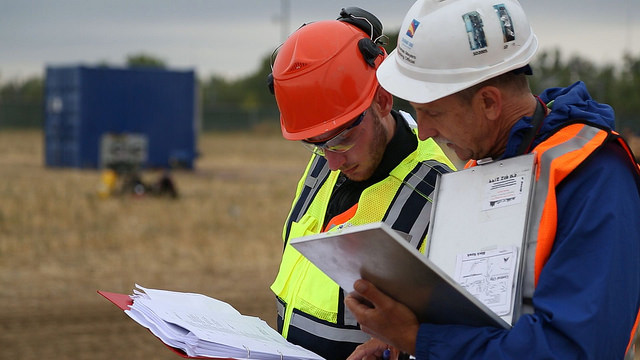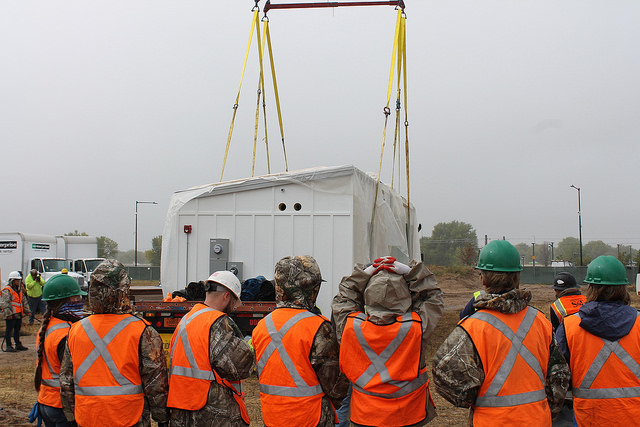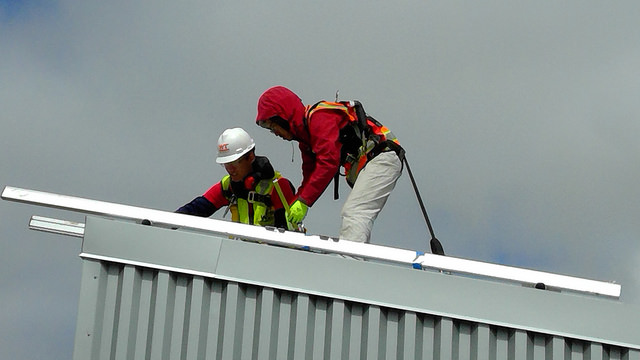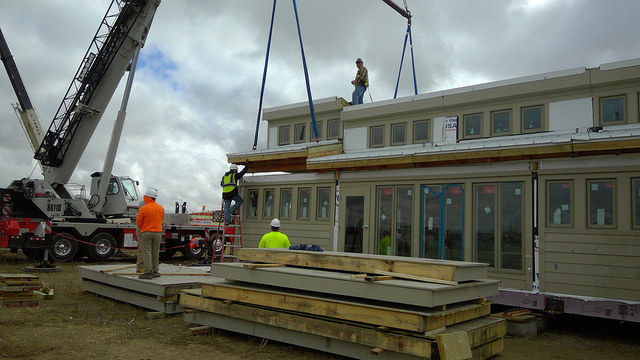They Build Through Rain, Sleet, Snow or Hail … (But, Hopefully Only Rain)
Tuesday, September 26, 2017
By Ruby Nahan
Despite the overcast skies, rain, and mud, there’s nothing but sunny dispositions at the U.S. Department of Energy Solar Decathlon 2017!
Teams arrived on site for an all-teams meeting and began assembly of their houses three days ago, on Saturday, September 23 (see our video for highlights). Pretty soon thereafter, it started to rain. Seems we hit an off week in Denver’s rumored 300 days of sun per year. But in the words of our brilliant building code official, Tom Meyers, “Weather. It’s the hidden 11th contest of the Solar Decathlon!”
 U.S. Department of Energy Solar Decathlon 2017 building inspector Tom Meyers confers with Koen Maas of the Netherlands team. Teams began assembly of their solar-powered houses at the 61st & Peña Station in Denver, Colorado, on Saturday, September 23, 2017. (Credit: Deb Lastowka/U.S. Department of Energy Solar Decathlon)
U.S. Department of Energy Solar Decathlon 2017 building inspector Tom Meyers confers with Koen Maas of the Netherlands team. Teams began assembly of their solar-powered houses at the 61st & Peña Station in Denver, Colorado, on Saturday, September 23, 2017. (Credit: Deb Lastowka/U.S. Department of Energy Solar Decathlon)
My check-in with the all the teams late Monday, September 25, revealed some consistent themes.
The teams are beyond excited just to be here. After working hard for two years, it’s finally real. Prior to arriving on the competition site, they’d only seen renderings of each other’s houses, so they are now seeing all the homes coming together for the first time—and the competition is stiff.
Brooke Carey of the UC Davis team said, “The best surprise is really seeing everyone’s houses, and seeing how they come in a lot differently than ours is kind of surprising. Day 1 and 2, I saw maybe two houses and a bunch of wood, and I wondered how they were going to do it.”
The UC Davis house came in looking nearly like a finished house, but, as Brooke said, “We come in fast and hard, but then we take a long time to set the modules. We’re still setting the modules. Even though it looks good, it’s still not connected. So, people will surpass us pretty soon.” And, she added, “the worst part is leveling everything in the rain. Everything’s sinking. We’ll be OK, but it’s definitely going to be down to the wire.”
UC Davis isn’t the only team lamenting the rain. According to UC Berkeley/U of Denver team member Brenton Kreiger, “The worst surprise so far was to find some water in our ceiling. Late last night, we realized it came in there when the modules were apart for a bit. Probably a disadvantage of being such a close local team [the team constructed their house on the University of Denver campus] that we just tacked on a tarp to send it over here. It hasn’t rained in a month! We’re just going to drain that water out, and it shouldn’t be a problem for the future.” Brenton emphasized the good news about the house, adding “how much easier it was getting the modules together than we thought it was going to be.”
A couple of the teams are expressing smooth sailing so far. Jenny Nickle from Missouri S&T mentioned that other than an unfortunate choice of hotels that necessitated a late-night move for the team, “the best surprise is that we’ve got off site pretty early so far. We’ve got our work done. We made a pretty good plan before we left Rolla. So far everything’s going according to plan. That’s probably the best thing.” Perhaps it really helps to represent a school that is competing in the Solar Decathlon for the seventh time!
 The U.S. Department of Energy Solar Decathlon 2017 Missouri University of Science and Technology team anxiously await as a crane prepares to hoist their house entry onto its foundation at the 61st & Peña Station, Denver, Colorado, September 25, 2017. When fully assembled, their house design, named SILO (an acronym from Smart Innovative Living Oasis), will combine farmhouse architecture with state-of-the-art technologies. (Credit: Cody Williams/U.S. Department of Energy Solar Decathlon)
The U.S. Department of Energy Solar Decathlon 2017 Missouri University of Science and Technology team anxiously await as a crane prepares to hoist their house entry onto its foundation at the 61st & Peña Station, Denver, Colorado, September 25, 2017. When fully assembled, their house design, named SILO (an acronym from Smart Innovative Living Oasis), will combine farmhouse architecture with state-of-the-art technologies. (Credit: Cody Williams/U.S. Department of Energy Solar Decathlon)
Bill Bach, student project manager for the Northwestern team, seemed similarly calm, “It all showed up on time and went together without too much difficulty. We didn’t have any major issues assembling the foundation, up to the whole thing, so I’m just happy with how it’s progressed so far.” Although he mentioned being surprised at that amount of “pushing and shoving” it took to get the house put back together than it did to take it apart, Bill’s confident the team is on schedule.
Team sizes really vary in the Solar Decathlon. Alla Elmahadi of the University of Maryland team says that in spite of having only eight team members on site who have had to work incredibly long hours, “We’ve managed to get quite a lot stuff done in a short amount of time. Things have actually been working out quite well. We had a little delay of our main module, but we managed to efficiently work in a way in which we could get our ones that were here craned into place. Actually, yesterday went really smoothly, which is great.” And, she added, laughing, “which hasn’t happened a lot in the last couple of months!” Monday, they worked on getting the rest of their modules in place, their windows set, and sliding glass doors in place, so they can begin work on their greenhouse. They plan to start work on the interior next.
 The U.S. Department of Energy Solar Decathlon 2017 University of Maryland team members Tim Kim and Alan Uy work on the roof of their house at the 61st & Peña Station, Denver, Colorado, September 25, 2017. The design, called reACT, is a prototype for sustainable, self-sufficient Native American housing that provides a way to live using materials that consider tribal environmental ethics. (Credit: Laurie Loweecey/U.S. Department of Energy Solar Decathlon)
The U.S. Department of Energy Solar Decathlon 2017 University of Maryland team members Tim Kim and Alan Uy work on the roof of their house at the 61st & Peña Station, Denver, Colorado, September 25, 2017. The design, called reACT, is a prototype for sustainable, self-sufficient Native American housing that provides a way to live using materials that consider tribal environmental ethics. (Credit: Laurie Loweecey/U.S. Department of Energy Solar Decathlon)
On the opposite end of the team-size spectrum are the Swiss Team and Team Netherlands. Both had to ship their houses across the ocean, and both saw their shipping containers come through the Port of Houston, Texas, right around the time Hurricane Harvey was causing devastating floods. You can’t ship a house module in a shipping container, so these teams are having to do what looks a little more like traditional “stick build.” (But, do not be fooled by appearances—there’s very little that’s traditional about how these houses are coming together.) Each team has approximately 40 team members in Denver for assembly. The Swiss Team is working in two shifts per day, and some organizers have nicknamed their working style, “Swiss Precision.”
Flavia Viscardi of the Swiss Team said the best thing so far is, “Meeting the other teams. And the fact that the competition is real now. We’ve been working on it two years, and now it’s concrete. The best thing is being in the United States and to actually build the dream.”
The team from the Netherlands was happy to discover that a shipping container that went missing in Houston, and they thought would arrive in Denver late, had in fact arrived on time. Jason Hoogerbrug, the student project manager, said, “the best surprise was that some containers came earlier than expected. The worst has been the bad weather on the first day. We had to get raincoats for everyone, and we weren’t prepared for that.” Given the Netherlands has double the annual rainfall of Denver, Colorado, you can read the lack of raincoats as simply smart light packing. After all, they did have to pack a house and all the tools to build it. Jason added, “We’re happy to be here, and it’s an amazing experience. We couldn’t imagine how big this was. It’s nice to see the other teams do such great work.”
Several teams have experienced delays in receiving their modules.
The Washington University – St. Louis team’s house is made of pre-fabricated concrete panels, and it takes about 12 semi-trucks to get them all to the site. Faculty advisor Hongxi Yin said the team’s most difficult challenge has been the logistics of coordinating all those shipments. He’s confident the team will put the house together quickly, because they’ve already built it and taken it apart once. It’s just that the panels have to be assembled in the reverse order in which they disassembled and shipped. The team needs one more core module, which left St. Louis Monday. They’re one whole day behind schedule, but Hongxi said, “That’s OK, because we planned for that.” Also, because the panels include interior wall finish, he believes there won’t be a lot of finish work to do.
Team Alabama’s faculty advisor, Bambi Ingram, also noted the team’s biggest challenge thus far has been, “the trucks not being on time and not being able to unload in a timely manner. And, our house didn’t come apart as well as we thought it would in Birmingham. It’s going back together much better. We’re just a little behind, but we’re catching up!”
Bambi added, “The best thing has been just seeing everyone come together and pull their houses together, and, also teams are really working really well together already. We’re sharing tools and equipment and helping each other out, so that’s been wonderful.”
 The U.S. Department of Energy Solar Decathlon 2017 team from the University of Alabama at Birmingham and Calhoun Community College uses a crane to assemble their house entry. Called surviv(AL) House, the design serves as a model for resilient housing for severe weather-prone communities and includes a safe room able to withstand 250 mph winds. (Credit: Laurie Loweecey/U.S. Department of Energy Solar Decathlon)
The U.S. Department of Energy Solar Decathlon 2017 team from the University of Alabama at Birmingham and Calhoun Community College uses a crane to assemble their house entry. Called surviv(AL) House, the design serves as a model for resilient housing for severe weather-prone communities and includes a safe room able to withstand 250 mph winds. (Credit: Laurie Loweecey/U.S. Department of Energy Solar Decathlon)
The University of Nevada, Las Vegas team’s house hasn’t arrived yet. According to Competition Manager Joe Simon, there was a hitch with a hitch. The Sinatra Living house is built on an integrated trailer frame. The truck hauler noticed a problem with the trailer hitch and was concerned about hauling it. The team had to have a new hitch designed and approved by their engineer of record. A new weld was needed, which happened Sunday, so now the house is moving and expected to arrive Wednesday, September 27, 2017.
No Solar Decathlon 2017 team has experienced greater delay than Team Daytona Beach. Remember that 11th contest mentioned earlier—weather? Well, Daytona Beach had to shut down construction on their site in Florida because of Hurricane Irma. Fortunately, the house did not sustain too much damage, and is on its way to Denver. Unfortunately, the team was not able to complete construction before the house shipped. Student project manager Jenna Beckwith says, “The entire team is in chipper spirits even though it’s cold and rainy,” and when asked about her optimism for completing assembly for the competition, she smiles, pumps her fists, and says, “Yes!” Now, that’s some much needed Florida sunshine!
Tags: Las Vegas, Missouri S&T, Netherlands, Northwestern, Solar Decathlon, Solar Decathlon 2017, Swiss Team, Team Alabama, Team Daytona Beach, UC Berkeley / U of Denver, UC Davis, University of Maryland, Wash U - St. Louis
